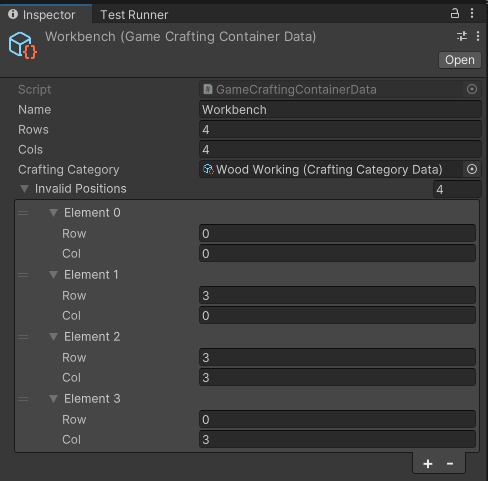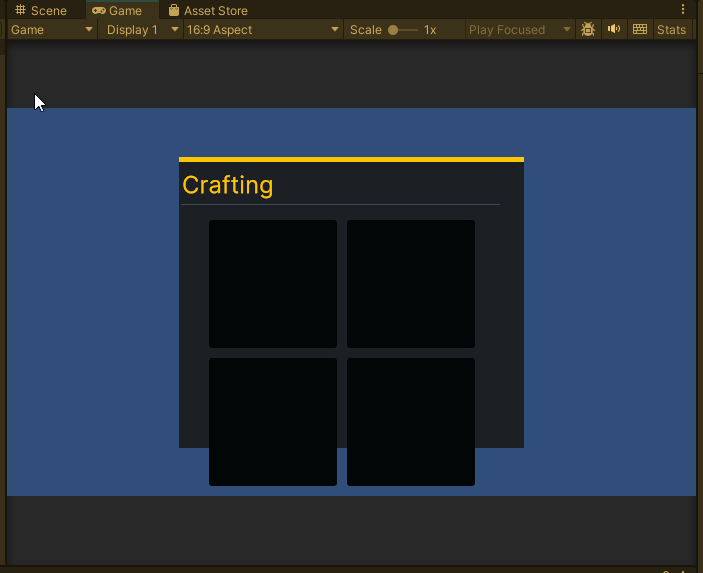Day 4: Interfaces and Exploring UI Toolkit
Today, we finished implementing the RecipeDatabase class, refactored the CraftingSystem to expose additional interfaces, implemented a CraftingContainerData ScriptableObject, and began exploring using the UI Toolkit in play mode.
Table of contents
Today’s Goals
-
Finish RecipeDatabase Class -
Write simple interface for each type that must be implemented -
Implement a CraftingContainerData ScriptableObject - Implement CraftingContainerGrid MonoBehaviour (Started!)
Finishing the RecipeDatabase Class
The first order of business was to complete the RecipeDatabase class that we started on Day 3. As a quick reminder, the RecipeDatabase provides the following API:
/// <summary>
/// Given ingredients and a category, attempts to find a recipe in the database.
/// If one is found, returns true and populates recipe. Otherwise, returns false
/// and the value of recipe is undefined.
/// </summary>
public bool TryGetRecipe(IEnumerable<T> ingredients, ICraftingCategory category, out IShapelessRecipe<T> recipe);
One of the primary goals from the original scope document is to have an efficient implementation of this method. That is, this method should not iterate over all possible recipes.
To accomplish this, we defined a nested RecipeEntry class which generates a hash code based on the ingredients and category such that the order of the ingredients is not important. Additionally, we implemented an Equals such that two RecipeEntry’s are considered equal if they contain the same ingredients regardless of order:
public class RecipeEntry
{
// This dictionary is a table which tracks the number of each ingredient
// in this recipe.
private readonly Dictionary<T, int> _itemCounts = new();
private readonly ICraftingCategory _category;
private readonly int _hashCode;
public RecipeEntry(IEnumerable<T> ingredients, ICraftingCategory category)
{
_hashCode = 0;
foreach(T item in ingredients)
{
// We sum the hashcode of each ingredient. This ensures
// the hashcode of any permutation of the ingredients will match
_hashCode += item.GetHashCode();
// Additionally, we build up a Dictionary that counts the number of
// each ingredients.
if(!_itemCounts.ContainsKey(item))
{
_itemCounts[item] = 1;
}
else
{
_itemCounts[item]++;
}
}
_category = category;
// The final hashcode should also take into account the category
_hashCode = HashCode.Combine(_hashCode, _category);
}
public override bool Equals(object obj)
{
return obj is RecipeEntry entry &&
// First check that the hash codes match
_hashCode == entry._hashCode &&
// Just in case of a hash collision, ensure that the categories are the same
_category.Equals(entry._category) &&
// Lastly, we must do a deep compare of the two dictionaries
// This must iterate through the dictionary and is the most inefficient
// part of the algorithm.
_itemCounts.KeyValuePairEquals(entry._itemCounts);
}
// We return the pre-cached hashCode
public override int GetHashCode() => _hashCode;
}
Checking the equality of two RecipeEntrys requires us to check if the ingredient counts are identical. This is because there is a possibility of a hash collision upon looking up the value in a dictionary or hash set.
To perform this check, we added a static DictionaryExtensions class to the CaptainCoder.Core library, that contains a KeyValuePairEquals method for performing a deep compare of two Dictionarys:
/// <summary>
/// Performs a deep comparison of all key value pairs in <paramref name="dict0"/> and <paramref name="dict1"/>.
/// </summary>
public static bool KeyValuePairEquals<K,V>(this Dictionary<K,V> dict0, Dictionary<K,V> dict1)
{
// First check if the count is the same. If it is not, no need to waste time checking all entries
if (dict0.Count != dict1.Count) { return false; }
// If the counts match, we need to compare all entries
foreach((K key, V value) in dict0)
{
// If we encounter any key in one dictionary that is not in the other, we return false
if (!dict1.TryGetValue(key, out V other)) { return false; }
// If a key returns null on both dictionaries,
// they match and we continue (can't call null.Equals)
if (value == null && other == null) { continue; }
// Lastly, we check for equality here. If equality fails,
// we return false.
if (value == null || !value.Equals(other)) { return false; }
}
return true;
}
Adding Simple Interfaces
On Day 3, we began to explore how we could use ScriptableObjects to define our recipes, items, and crafting containers. For example, the CraftingContainerData from Day 3 looked like this:
[CreateAssetMenu(fileName = "CraftingCategory", menuName = "Crafting/Category", order = 2)]
public class CraftingCategoryData : ScriptableObject
{
[field: SerializeField]
public string Name { get; private set; }
public CraftingCategory AsStruct => new (Name);
}
Yesterday, I noted that the AsStruct method felt gross to me and that it might make sense to create an ICraftingCategory. Doing so would allow us to pass the CraftingCategoryData directly into the Crafting System library rather than being required to provide an AsStruct. From a reusability stand point, I feel this makes for a better user experience. Thus, we created a few interfaces and refactored the Crafting System code to use them:
public interface ICraftingCategory
{
public string Name { get; }
}
public interface IShapelessRecipe<T> where T : IItem
{
public IEnumerable<T> Ingredients { get; }
public IEnumerable<T> Result { get; }
public ICraftingCategory Category { get; }
}
public interface ICraftingContainer<T> where T : IItem
{
public int Rows { get; }
public int Columns { get; }
public HashSet<ICraftingCategory> Categories {get; }
public HashSet<Position> InvalidPositions { get; }
public IEnumerable<(Position, T)> Positions { get; }
public bool TryAddItem(Position position, T item);
public bool TryMove(Position from, Position to);
public bool TryRemove(Position position, out T removed);
public bool TryItemAt(Position position, out T result);
public T ItemAt(Position position);
public bool HasItemAt(Position position);
}
Next, we updated each of the associated types to implement these interfaces.
Implement a CraftingContainerData ScriptableObject
With the ICraftingContainer interface available, we next implemented a scriptable object version: CraftingContainerData. The class signature looks like this:
public class CraftingContainerData<T> : ScriptableObject, ICraftingContainer<T> where T : IItem {}
You may recall that we implemented the functionality of ICraftingContainer in the CraftingContainer class on Day 3. But, we cannot extend it here because we are already extending ScriptableObject. However, we would like to reuse that functionality without copy / pasting the code. To accomplish this, we want to use a delegate field and forward all of the interface methods to an implementation:
public class CraftingContainerData<T> : ScriptableObject, ICraftingContainer<T> where T : IItem
{
// We will do some magic with this "Delegate" property soon.
// For now, assume it is a concrete implementation
private ICraftingContainer<T> Delegate { get; }
// If we are able to set the Delegate properly, we can just forward
// the responsibility to it for each of these methods
public int Rows => Delegate.Rows;
public int Columns => Delegate.Columns;
public HashSet<ICraftingCategory> Categories => Delegate.Categories;
public HashSet<Position> InvalidPositions => Delegate.InvalidPositions;
public IEnumerable<(Position, T)> Positions => Delegate.Positions;
public bool HasItemAt(Position position) => Delegate.HasItemAt(position);
public T ItemAt(Position position) => Delegate.ItemAt(position);
public bool TryAddItem(Position position, T item) => Delegate.TryAddItem(position, item);
public bool TryItemAt(Position position, out T result) => Delegate.TryItemAt(position, out result);
public bool TryMove(Position from, Position to) => Delegate.TryMove(from, to);
public bool TryRemove(Position position, out T removed) => Delegate.TryRemove(position, out removed);
}
In the inspector, we would like to be able to specify the values necessary to construct a concrete CraftingContainer:
public class CraftingContainerData<T> : ScriptableObject, ICraftingContainer<T> where T : IItem
{
[field: SerializeField]
public string Name { get; private set; }
[SerializeField]
private int _rows;
[SerializeField]
private int _cols;
[SerializeField]
private CraftingCategoryData _craftingCategory;
[SerializeField]
private List<InvalidPosition> _invalidPositions;
// The CaptainCoder.Core.Position is a readonly struct that cannot be displayed in the
// Unity inspector so we implement a very simple wrapper for it.
[System.Serializable]
internal struct InvalidPosition
{
public int Row;
public int Col;
}
}
And lastly, we implement the Delegate getter such that it initializes once at runtime based on the values specified in the inspector:
public class CraftingContainerData<T> : ScriptableObject, ICraftingContainer<T> where T : IItem
{
// Actual backing field
private ICraftingContainer<T> _delegate;
private ICraftingContainer<T> Delegate
{
get
{
// First time we try to access the delegate we initialize it
if (_delegate == null)
{
_delegate = new CraftingContainer<T>(
_rows,
_cols,
_craftingCategory,
_invalidPositions.Select(pos => new Position(pos.Row, pos.Col)));
}
return _delegate;
}
}
}
Implementing a Concrete CraftingContainerData
Similar to ShapelessRecipeData<T> the CraftingContainerData<T> class uses a generic type and thus cannot be instantiated directly in the inspector. To do this, we create a very simple concrete implementation GameCraftingContainerData.cs:
[CreateAssetMenu(fileName = "Container", menuName = "Crafting/Container", order = 3)]
public class GameCraftingContainerData : CraftingContainerData<ItemData> { }
And just like magic, we can now specify a variety of crafting containers directly in Unity.

Start Work on UI
At this point, I believe we have the majority of the Crafting System logic finished. All that seems to be left is to create a UI and hook it all up.
My last learning goal is to learn how to use the new UI Toolkit in play mode. Thus, we began delving into using it. Luckily, MooNiZZ was watching and recommended a tutorial on making a grid based inventory (hey! That sounds very similar to what we want!).
We followed along with this tutorial: LINK
We didn’t finish yet, but we have the start of a crafting UI that we shall continue working on tomorrow:

Whew! We made it! Looking forward to continuing this tomorrow!
Join the Discussion
Before commenting, you will need to authorize giscus. Alternatively, you can add a comment directly on the GitHub Discussion Board.